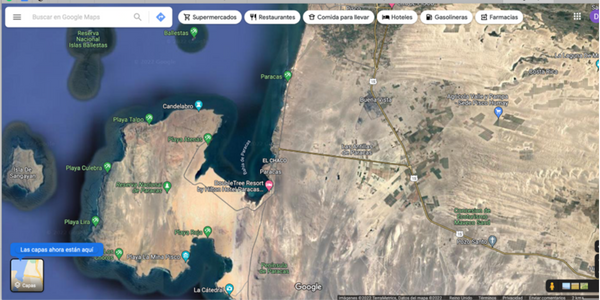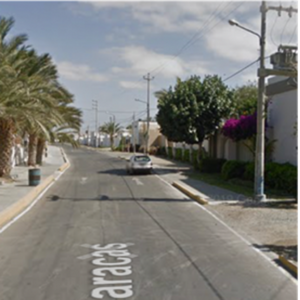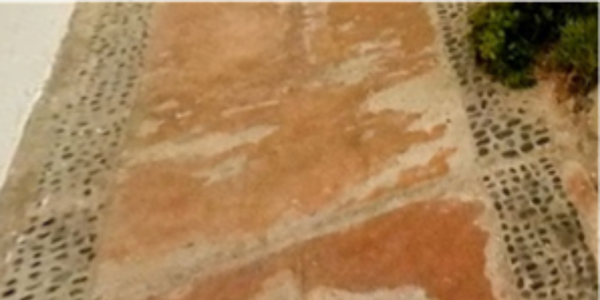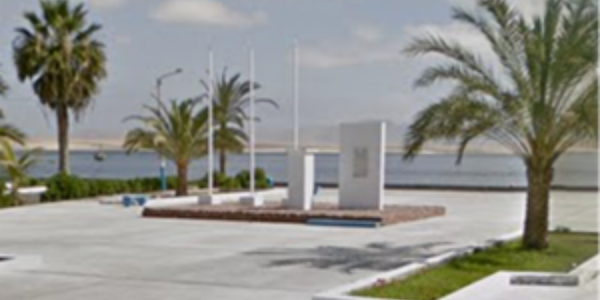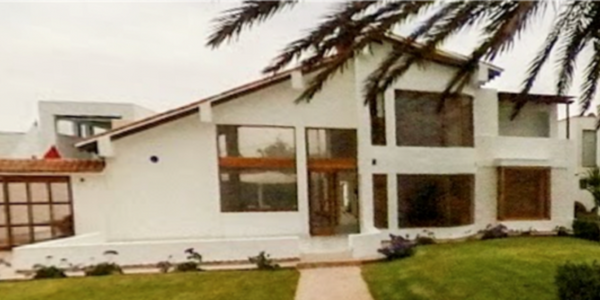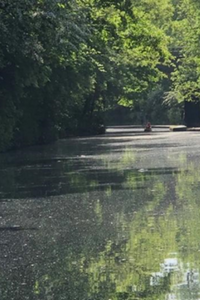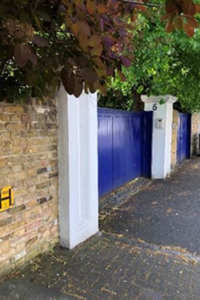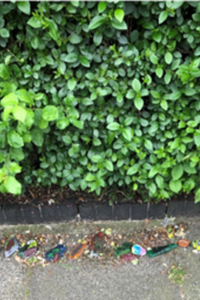by Daniela Meneses
I must have been four or five, but I have always thought of it as something without a beginning, something that always already was. Every summer and every winter, I would spend the school vacations in Paracas, a small town by the Peruvian coast. I would stay there with my paternal grandmother, my brother and my cousin. Sometimes we drove to a payphone to call my parents; they came to visit on weekends.
My grandmother sold our house in Paracas in 1999, the year I celebrated my tenth birthday. My parents split up that same year, a few months before my mother, my brother and I moved to Venezuela. Selling our house did not seem to be an important event for most of the adults in my life. I remember my parents focusing on the rational explanation: owning the house was too expensive, my grandmother could not afford it. But I also remember my grandmother’s sadness. And I remember sitting in class, some months before the sale was finalised, writing in the rear side of an exercise sheet, as if it were a secret message for a teacher I liked so much: No quiero que mi abuela venda la casa en Paracas. I don’t want my grandma to sell the house in Paracas.
Since then, I have been turning my back to that place, fearful of revisiting what I lost when the house was sold, when my parents divorced, when I left Perú. Fearful of revisiting my grandmother’s younger self. And just so, twenty years go by. It is now March 2020, and the Covid-19 pandemic is already starting to disrupt our lives. In London, I feel farther away from home than I have ever felt. And I cannot explain why, but I am gripped by the desperate need to go back.
A back turned away
A back turned away from a place can be understood through Ahmed’s work on phenomenology, affect, and orientation (2006, 2014). Since, for Ahmed, affect is relational, by focusing on my affective relationship with Paracas, I situate my experience as one related to a more general object: the emotions that “stick” to lost homes. Moving away from Ahmed, and following Ann Cvetkovich (2003), I explore how trauma, with all its affective complexity, may be pulling me away from Paracas. In An Archive of Feelings, Cvetkovich distances herself from the pathologizing approach that has often been used to study trauma (2003: 2-4), and focuses on it from a sociocultural perspective (2003: 17) that treats the “specificities of individual experiences of trauma” (2003: 31-32) as a point of entry that gives space to the feelings and emotions that constitute trauma’s affective complexity: loss, mourning, anger, shame, love, grief, intimacy, or humour (2003:7 and 48). The traumatic events she discusses are, among others, events related to migration and the loss of home (2003: 120 and 122). The texts and videos she analyses contain stories where trauma is associated “not only with departure and exile but with the difficulty of return” (2003: 125). I mention Cvetkovich’s engagement with migration stories because I believe my experience of losing a home can be placed in this realm. My story is not associated with catastrophic events nor with transnational capitalism. It does not originate in a protracted migration process or national crisis. But it is a story of losing a home, and of not being able to return. And it is a story, or so I hope, that will resonate with many people that have lost a childhood home, and as such experienced a loss that can be difficult to communicate to others.
Studying a traumatic event is not an easy task, and Cvetkovich alerts us to this:“Because trauma can be unspeakable and unrepresentable and because it is marked by forgetting and dissociation, it often seems to leave behind no records at all. Trauma puts pressure on conventional forms of documentation, representation, and commemoration, giving rise to new genres of expression, such as testimony.” (2003: 7-8, italics are mine)
As if to confirm the ‘unspeakability’ that trauma often carries with it, I have no record of the feelings that I have experienced since 1999. The exercise sheet, with that single sentence declaring I did not want the house to be sold, is long lost. However, I found an alternative way to dive into my “archives of feelings”; namely, by engaging in an autoethnography of my return to Paracas. This strategy enables me to explore the phenomenology of trauma, while focusing on the ways in which I experience my loss through the feelings that I still carry with me, and that are the “only sign that trauma’s effects are still being felt” (Cvetkovich 2003: 3). This method is also key in that it will entail the exploration of how my personal story relates to others’ (Ettore 2017: 2; Averett 2009: 361; Cvetkocich 2003:10). In this sense, the ideas explored in the next section will surely be very personal, but I am actually exploring one instance of a broader, shared experience: how lost objects are “sticky” with trauma’s affective complexity.
Vibrant home
My return to Paracas begins at a table in the British Library (of all places). Going back using Google Maps seems the only option: not just because of the physical impossibility of doing otherwise, but also because I feel like this might be the only emotionally bearable alternative available to me.
Photograph by author
After finding Paracas on the map, I zoom in and quickly identify the main road that I know will lead me to my old house. I travel along the road. Was the back door one of those with rounded tops? The signs that I know should be there (the bell that we jumped up to ring every time we got to the house, the iron-wrought letters that announced its name: Las Conchitas) are nowhere to be found. I start to panic. How will I feel If I find out that the house has been torn down? And what happens if, in fact, it is still there, and I am just incapable of recognising it? Have I lost it forever?
Images from googlemaps and googlemaps streetview
Strangely, my panic starts giving space to something else. I begin to feel comfort in seeing the chipped paint so characteristic of the town; chipped paint that serves as a reminder of the wind, the sea and its salt, and the desert sand that are persistently throbbing in Paracas. Zooming in on the pictures that I find on Google Maps, the little pebbles that used to hurt my feet make an appearance. I cannot take my eyes off the plants that drink from the sea.
Images from googlemaps streetview
Returning to Paracas means encountering something that I was not expecting: objects full of life. In ‘Vibrant Matter’, Jane Bennett addresses “the capacity of things -edibles, commodities, storms, metals- not only to impede or block the will and designs of humans but also to act as quasi agents or forces with trajectories, propensities, or tendencies of their own” (Bennett 2010: viii). Being open to the vitality of objects, she says, allows people to realize that they, too, have agency. To realize, that is, that they interact with each other and have effects on people’s bodies (Bennett 2010: xii and 5).
My encounter with Paracas is an encounter with vibrant objects. Looking at that terracotta-coloured floor reminds me of the countless times I walked that waterfront. I used to walk around barefoot, and by the end of the summer my feet would get so used to the heat that my soles no longer burned. Looking at this picture, I feel it: how much this place has of me. How it carries with it things I no longer possess. How it is filled with the sweat, and skin, and fluids of a younger me. I see the town square that got to know my tears and blood the day my parents decided to teach me how to ride a bicycle. I look at the cold ocean: permeated with the sweat I carried to it after playing; fed by my pee.
Images from googlemaps streetview
What I (re)encounter is an assemblage: “living, throbbing confederations” of this vital matter (Bennett 2010: 23-24). An assemblage made of waves and sound, wind and desert storms, living creatures of land and sea, the smell of the sea and the algae. I can feel these assemblages:
“The materiality of the glove, the rat, the pollen, the bottle cap, and the stick started to shimmer and spark. It was in part because of the contingent tableau that they formed with each other, with the street, with the weather that morning, with me. For had the sun not glinted on the black glove, I might not have seen the rat; had the rat not been there, I might not have noted the bottle cap, and so on. But they were all there just as they were, and so I caught a glimpse of an energetic vitality inside each of these things, that I generally conceded as inert. In this assemblage, objects appeared as things, that is, as vivid entities not entirely reducible to the context in which (human) subjects set them, never entirely exhausted by their semiotics” (Bennett 2010: 5, italics are mine).
In (re)encountering Paracas, I am also (re)encountering an assemblage of vital materiality. I feel this even stronger when, finally, I see it. My house: not just a repository of memories, but a vibrant object that still holds what my family and I left there. Dust made of our skin. Walls carrying our touch. Rooms bearing the echoes of our voices. The traces of our life.
Image from googlemaps streetview
Looking at the big window in our old room, I remember lying in my grandmother’s bed, my bed, and being told the story of the man who went to our house to die. I faintly remember his name being something close to Claude, but maybe I have forgotten it. He knew he was dying, and my grandmother lent him the house so he could spend his last days by the sea. I was told he loved to use the bathtub: the same bathtub we used every day, the same bathtub that is being used now by bodies that do not carry my blood. I start recalling further back, and remember a poem by the Peruvian writer Antonio Cisneros (1999). And, at least for this one moment, it seems right to take his words out of their original context, and to only listen to the ways in which they are speaking directly to me:
Paracas
Desde temprano
crece el agua entre la roja espalda
de unas conchas
y gaviotas de quebradizos dedos
mastican el muymuy de la marea
hasta quedar hinchadas como botes tendidos junto al sol.
Sólo trapos
y cráneos de los muertos nos anuncian que bajo estas arenas
sembraron en manada a nuestros padres.[1]
Rethinking trauma and its affective complexity
Trauma is often thought about in close connection with feelings of touch and experiences of penetration, of being invaded (Cvetkovich 2003: 50). And although I realize losing a home has meant a loss that, much like trauma, “creates a continuum between the physical and the psychic” (2003:51), I understand that the idea of penetration does not adequately capture my experience of trauma. The trauma of losing a home, an assemblage, was the experience of being ripped apart, of losing my place in an assemblage, of a life carrying on without me. My bodily boundaries, the difference “between self and other, between inside and outside”, were not breached (2003: 51 and 80), they were just suddenly (re)drawn. I have often grieved the loss of Paracas. But it is only now that I fully realize the object of my grief: myself. I grieve the death of the assemblage I was part of. I grieve the loss of who I was with the dark blue sea, the sandy wind, the pungent smell of the coast. The burning sun and me. I grieve being-with my grandmother.
This journey back home brings another realization: this vibrant assemblage is “sticky” with trauma’s affective complexity. Eventually, I stop seeing only the sadness and grief; I start seeing how the town square holds the joy of riding a bike with my parents; the sand, the excitement of feeling the cold water in my toes; the house, the love of starting every morning with my grandmother scratching my back. Through this second realization, I am reminded of how Cvetkovich and other authors whose work relates to hers (such as Marianne Hirsch and Cecilia Sosa) have studied the affective power of things. Material objects “invested with emotional, and even sentimental, value” (Cvetkovich 2003: 7-8). Testimonial objects that “carry memory traces from the past” and “testify to […] the daily qualities of the past moments in which they were produced” (Hirsch and Spitzer 2012: 178). Souvenirs that are “cultural treasures” and that remind us of an agreement between generations (2014: 108- 109, 113).
And while I agree that Paracas is replete with affect-laden objects that carry memories from the past that connect me to it, I realize something escapes the above passages: the affective objects in my home cannot be understood independently, as mere lifeless objects that serve as a memory object for me. They are part of a vibrant assemblage, an assemblage that existed before me, that existed once with me, and that will carry on with traces of me. The vibrant affective objects I encounter are part of a larger assemblage; a vibrant assemblage sticky with the affective complexity that surrounds the trauma of lost objects: pain, and loss, and grief, but also joy, love and happiness. And so, returning to Paracas, I understand that, deep down, my back has never been truly turned away from the place: although the sadness and grief I felt might have been louder, the joy and the love and the happiness never stopped trying to pull me in.
By way of conclusion: What I take with me
Eng and Kazanjian write, in their introduction to Loss, The Politics of Mourning: “We might say that as soon as the question ‘What is lost?’ is posed, it invariably slips into the question ‘What remains?’ That is, loss is inseparable from what remains, for what is lost is known only by what remains of it, by how these remains are produced, read, and sustained” (2003: 2). I have explored the loss of my house through the feelings that I carry with me, and through the assamblage that still to this day is filled with my traces. But there is something else that remains.
I spend the weeks following my return to Paracas in a locked-down London: my daily walks confined to the streets surrounding my flat. Streets that could not be further away from Paracas, but where (for the first time in 20 years) the joy and happiness and love of my lost home have started to find a place.
It all begins with dead fish. I see a dead fish in the canal at Regent’s Park, and I remember the time when my mother used the massive death of animals in the bay caused by an event I can’t quite remember anymore (was it rising sea temperatures? or something related to an oil spill?) to give me a semi-scientific, semi-religious explanation of natural selection. I see some painted rocks on the sidewalk. I am reminded of the time I sat on my doorstep and tried to sell painted rocks to the passers-by that strolled along the waterfront.
I do not carry objects of Paracas with me. But being open to the multiple affects that surround trauma, I start to see in my everyday the multiple ways in which Paracas draws me back. Just as I left traces of me in Paracas, I bring with me the remains of that ripping apart. I see, then, how my London neighbourhood carries the traces of lost homes. And I see, then, the vibrancy of my new assemblage, an assemblage full vital materiality and “sticky” with affective complexity.
My grandmother, Giovanna Cattaneo, passed away on November 2022. In a few weeks, we will be returning to Paracas to spread her ashes.
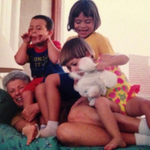 Daniela Meneses Sala is a Phd student at the University of Cambridge’s Centre of Latin American Studies, and a recipient of the Harding Distinguished Postgraduate scholarship. Currently, she is researching Peruvian feminist activism and queer archives. Daniela holds an MSc in Gender(Sexuality) from LSE, an MSc in Public Policy from UCL, and a Law Degree from Pontificia Universidad Católica del Perú. In addition to her academic career, she has a decade of experience as a journalist.
Daniela Meneses Sala is a Phd student at the University of Cambridge’s Centre of Latin American Studies, and a recipient of the Harding Distinguished Postgraduate scholarship. Currently, she is researching Peruvian feminist activism and queer archives. Daniela holds an MSc in Gender(Sexuality) from LSE, an MSc in Public Policy from UCL, and a Law Degree from Pontificia Universidad Católica del Perú. In addition to her academic career, she has a decade of experience as a journalist.
Acknowledgements: I want to thank Dr. Leticia Sabsay for her feedback and encouragement while writing the first version of this article. I also want to thank Luma, from Engenderings editorial collective, for their kind edits.
Bibliography
Ahmed, Sara (2006). “Introduction: Find Your Way”. In: Queer Phenomenology. Orientations, Objects, Others. Durham and London: Duke University Press. pp.1-24.
Ahmed, Sara (2014). The Cultural Politics of Emotion. Second Edition. Edinburgh University Press. Averett, Paige (2009). “The Search for Wonder Woman. An Autoethnography of Feminist Identity”.
Affilia: Journal of Women and Social Work. 24:4. pp.360-368.
Bennett, Jane (2010). Vibrant Matter. A Political Ecology of Things. Durham and London: Duke
University Press.
Cisneros, Antonio (1999). “Paracas”. In: Postales Para Lima. Ediciones Colihue. p.29
Cvetkovich, Ann (2003). An Archive of Feelings. Trauma, Sexuality and Lesbian Public Cultures. Duke University Press: Durham and London.
Cvetkovich, Ann (2012). “Introduction”. In: Depression a public feeling. Duke University Press: Durham and London.
Eng, David L. And David Kazanjian (2003). “Introduction. Mourning Remains”. In: Loss, The Politics of Mourning. University of California Press. pp.1-25.
Ettorre, Elizabeth (2017). Autoethnography as Feminist Method. Sensitising the feminist ‘I’. Routledge: London and New York.
Haynes, Kathryn (2013). “Sexuality and sexual symbolism as processes of gendered identity formation. An auto ethnography of an accounting firm”. Accounting, Auditing & Accountability Journal. 26:3. pp.374-398.
Hirsch, Marianne and Leo Spitzer (2012). “Testimonial Objects”. In: Hirsch, Marianne. The Generation of Postmemory. Columbia University Press. pp. 176-179.
Huyssen, Andreas (2016). “Memory things and their temporality”. Memory Studies. 9:1. pp. 107-110.
Sosa. Queering Acts of Mourning (2014). Queering Acts of Mourning in the Aftermath of Argentina’s Dictatorship. Boydell & Brewer: Tamesis.
[1]I have not found this poem translated to English, and I cannot pretend to be a translator, but here is an attempt aided by Google Translator: Paracas / From early morning / water grows between the red back / of some shells / and brittle-toed gulls / chew on the mole crab of the tide / until they are left swollen like boats / lying under the sun. / Only rags / and the skulls of the dead tell us / that under these sands / our parents were sowed like herds.


